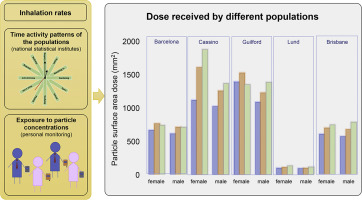Environmental Pollution ( IF 7.6 ) Pub Date : 2017-09-15 , DOI: 10.1016/j.envpol.2017.09.023 A. Pacitto , L. Stabile , T. Moreno , P. Kumar , A. Wierzbicka , L. Morawska , G. Buonanno

|
In the present study, the daily dose in terms of particle surface area received by citizens living in five cities in Western countries, characterized by different lifestyle, culture, climate and built-up environment, was evaluated and compared. For this purpose, the exposure to sub-micron particle concentration levels of the population living in Barcelona (Spain), Cassino (Italy), Guilford (United Kingdom), Lund (Sweden), and Brisbane (Australia) was measured through a direct exposure assessment approach. In particular, measurements of the exposure at a personal scale were performed by volunteers (15 per each population) that used a personal particle counter for different days in order to obtain exposure data in microenvironments/activities they resided/performed. Non-smoking volunteers performing non-industrial jobs were considered in the study.
Particle concentration data allowed obtaining the exposure of the population living in each city. Such data were combined in a Monte Carlo method with the time activity pattern data characteristics of each population and inhalation rate to obtain the most probable daily dose in term of particle surface area as a function of the population gender, age, and nationality.
The highest daily dose was estimated for citizens living in Cassino and Guilford (>1000 mm2), whereas the lowest value was recognized for Lund citizens (around 100 mm2). Indoor air quality, and in particular cooking and eating activities, was recognized as the main influencing factor in terms of exposure (and thus dose) of the population: then confirming that lifestyle (e.g. time spent in cooking activities) strongly affect the daily dose of the population. On the contrary, a minor or negligible contribution of the outdoor microenvironments was documented.
中文翻译:

生活方式对不同西方人群接受的空气传播颗粒表面积剂量的影响
在本研究中,评估和比较了生活在西方国家的五个城市中,生活习惯,文化,气候和居住环境不同的居民在颗粒表面积方面的日剂量。为此,通过直接暴露来测量居住在巴塞罗那(西班牙),卡西诺(意大利),吉尔福德(英国),隆德(瑞典)和布里斯班(澳大利亚)的人口的亚微米颗粒浓度水平。评估方法。特别是,由志愿者(每个人口15人)在个人规模上进行暴露量的测量,这些志愿者使用个人颗粒计数器在不同的日子,以获取他们所居住/进行的微环境/活动中的暴露数据。研究中考虑了从事非工业工作的非吸烟志愿者。
颗粒物浓度数据可以获取每个城市人口的暴露情况。这些数据在蒙特卡洛方法中与每个人群的时间活动模式数据特征和吸气率结合起来,以获得最可能的日剂量(以颗粒表面积计),该剂量是人群性别,年龄和国籍的函数。
据估计,生活在卡西诺和吉尔福德的公民的日剂量最高(> 1000 mm 2),而隆德公民的最低剂量被认为是最低剂量(约100 mm 2)。就人群的暴露(以及剂量)而言,室内空气质量,尤其是烹饪和饮食活动被认为是主要的影响因素:然后确认生活方式(例如,烹饪活动所花费的时间)严重影响了儿童的日剂量。人口。相反,据记录室外微环境的贡献很小或可忽略不计。











































 京公网安备 11010802027423号
京公网安备 11010802027423号